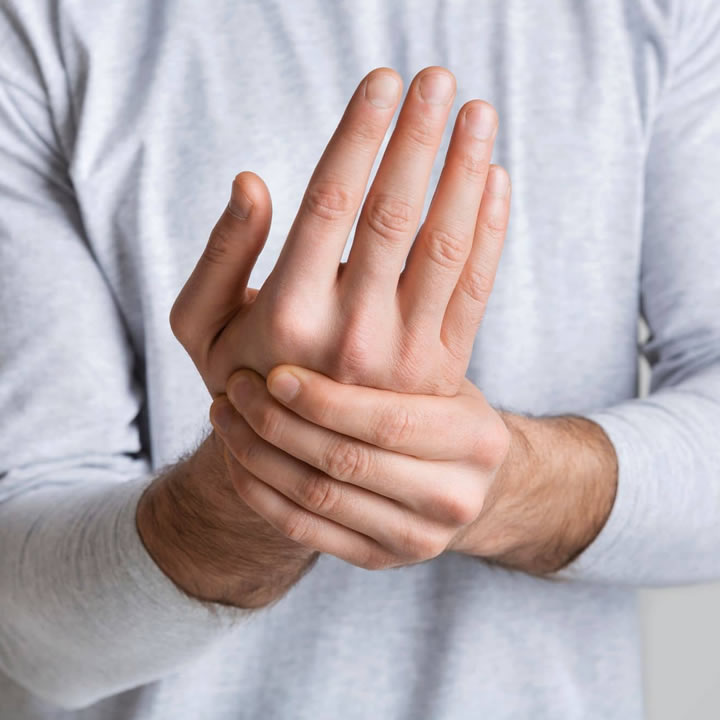The median nerve travels into the palm of the hand from the forearm. It is responsible for providing sensation to the thumb, index finger, middle finger, and a part of the ring finger.
The median nerve passes through a tunnel comprising ligaments and bones at the base of the hand this tunnel is known as the carpal tunnel.
Sometimes swelling or increased pressure on tendons at the carpal tunnel causes the tunnel to narrow down which results in the compression of the median nerve. Generally, this compression occurs at the wrist and can cause numbness, pain, or weakness in the hand. This condition is known as carpal tunnel syndrome.
Carpal tunnel syndrome (CTS) can be due to injury, fracture, fluid retention during menopause, a job like excessive typing, using vibrating tools like drills, etc. It can result in numbness in the region, and hand weakness that makes grasping objects difficult and in the chronic case can make the loss of hot and cold sensations.
How to treat carpal tunnel syndrome?
Carpal tunnel syndrome treatment includes both non-surgical methods and surgical methods.
Non-surgical methods include the usage of splints, changes in lifestyle and day-to-day activities, medicines to relieve pain and swelling, usage of corticosteroids for relieving pressure and swelling on the median nerve, and other alternative therapies like acupuncture, and electroacupuncture.
Surgical carpal tunnel syndrome treatment involves ligament severing so as to reduce the pressure on the median nerve. The surgery may include open-release surgery or endoscopic surgery.
Since the condition of carpal tunnel syndrome (CTS) requires surgery more and more conservative non-surgical methods to treat carpal tunnel syndrome are looked upon. Electroacupuncture has proven to be promising in treating carpal tunnel syndrome.
Electroacupuncture for treatment
Small battery-driven gadgets are used to stimulate the needles of acupuncture. A very mild current is passed through these needles to stimulate the specific pressure points.
Similar to manual acupuncture electroacupuncture session lasts for about 30 minutes and is repeated once or twice.
In a typical electroacupuncture session, the acupuncturist will first evaluate the symptoms of carpal tunnel syndrome and select the pressure points for the treatment. Needles will be inserted at the selected treatment point and nearby points at the proper depth.
Electrodes will be connected to the needles and an electroacupuncture machine.
The electroacupuncture machine has the option of voltage and current settings where low voltage and frequencies can be adjusted based on the need of the treatment. The electric current passes through the needles for about 10 to 20 minutes.
The patient may feel a vibrating or tingling sensation during the treatment.
Generally, electroacupuncture is considered a very safe method of treatment.
But in some cases, patients feel certain side effects like mild nausea, complaint of dizziness, pain during the insertion of the needle, redness at the needle side, or infection due to the needle when the needle is not sterile.
Electroacupuncture therapy should be avoided if the patient is pregnant or is having heart disease or has a pacemaker or experiences epileptic attacks. Henceforth you should discuss your medical condition thoroughly with your health practitioner before undergoing electro-acupuncture therapy.
How effective is electroacupuncture therapy in carpal tunnel syndrome treated?
Recent research has revealed that carpal tunnel syndrome treatment through electroacupuncture shows promising results.
Patients who underwent carpal tunnel syndrome treatment via electroacupuncture reported a decrease in the severity of the symptoms, a decrease in the disability of the hand, and increased functionality.
It helps in improving dexterity but it did not provide any significant relief from the pain.
Since electroacupuncture does not provide any relief from pain modern advanced methods for combining electroacupuncture are researched. Acupotomy emerged as a promising advanced method that combines the ideologies of acupuncture and scalpel to give relief from pain.
Autonomy has been effective in reducing pain and research on combining an electric puncher with Acupotomy for treating carpal tunnel syndrome (CTS) has been carried around.
Acupotomy is a special type of acupuncture, which involves the addition of a scalpel function to the existing acupuncture needle.
Early medical research has shown promising results in using acupotomy along with electroacupuncture therapy for carpal tunnel syndrome treatment. According to the research finding this combination therapy has great clinical application value for treating carpal tunnel syndrome (CTS).
It helps in increasing the mobility of the fingers, reduces the discomfort of the palm, and enhances the quality of life by providing relief from the pain caused due to carpal tunnel syndrome.
Conclusion
Carpal tunnel syndrome (CTS) is a common problem among adults and women are more prone than men to developing carpal tunnel syndrome. Carpal tunnel syndrome can hinder your day-to-day activity and can cause severe discomfort.
Persons with diabetes and those who have metabolic disorders are also susceptible to developing carpal tunnel syndrome. Getting a good treatment provides relief from tingling sensation, and numbness, and helps in restoring rest functions.
For chronic carpal tunnel, syndrome surgery is the only option but for mild symptoms, alternative therapies like splints and electroacupuncture have shown promising results.
The choice of treatment shell varies from the person-to-person condition and should be decided by an expert health practitioner.

